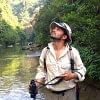
Sayam U Chowdhury
Sayam U Chowdhury is a Conservation Biologist, currently working on threatened species conservation and research in Bangladesh and abroad.
Sayam U Chowdhury is a Conservation Biologist, currently working on threatened species conservation and research in Bangladesh and abroad.
The sky hung low over Dhaka, wrapped in winter smog that blurred the sun and muffled the city's sounds. A heavy silence lingered as we made our way through the chaos of Sadarghat, boarding an overnight ferry bound for the coast. We were escaping the choking haze in search of open skies and tidal
At least five new birds were seen for the first time in Bangladesh between May 21 and 22 this year.
It’s quite an incredible feat to still have more than 600 species of birds in our country and with the increasing numbers of birdwatchers and wildlife photographers every year, many new species are being discovered or rediscovered.
We awoke before sunrise to the sound of rain and the smell of wet earth, slightly worried about the trail that we were taking for the
Cool morning air brushed against my face as I looked at the plains where countrymen were out on their fields--plowing, irrigating, or
A narrow 50-meter creek running along a muddy road next to our house was a passage for fish and other aquatic animals.
Unlike winter, monsoon is a quiet season for bird-watchers and travellers but the season holds its own beauty. For nature lovers, it's a
I remember my failed attempts to draw the convoluted coast of Bangladesh during art classes possibly 25 years ago.
Have you ever been to our hills, deep enough to know its real inhabitants? I suspect very few of us have been beyond the boundaries of the hill-towns.
Have you seen the barn owl in the moonlight, inaudibly searching for a field mouse to feed its young or the flying squirrel leaping from one tree to another filtering the light and the shadow of the moon? Have you seen an egret flying into the moon, or just one dwarf tree standing alone in the plains under the full moon, creating a black and white negative of its daytime image?
Dhaka was surprisingly fogless as I headed southward towards the sea at dawn that late December. It was the last mode of transport for the day to get to Hatia Island when I reached the 'ghat'. The destination, Domar Char, the wave island, one of two detached limbs of Hatia Island, the other being Nijhum Dwip, the silent island.
Bangladesh has seen enough damage to its resources even prior and post 1971 and now 42 years after liberation, perhaps it is time to stop the selfish agendas, cutting and destroying and initiate the restoration what was once already there, for at least the chance of a greener tomorrow.
Far from the Bay, along the foothills of the Chittagong Hill Tracts, a few trees still stand tall and have witnessed hundreds of winters, summers and monsoons. Still they propel water with love to the village surrounded by their green turf, they provide shade while we chop them down into pieces; the trees offer us fruits to eat or give blossoms that add colour and fragrance to our horizons. While searching for peace from the uncompassionate, unsafe, unyielding, unfair and urban means of city life, I wandered through the thin vegetation and empty hilltops.
Here in the Waterland, people are yet to learn the trick of hiding their true faces behind well-polished material masks. They are not crowned with higher education nor do they wear foreign fragrances to veil the magnitude or odour of the little or the immoral sins they commit. When I looked at those fishermen who returned from fishing in 'no-fishing areas', I could clearly see the guilt and the fear reflecting in their eyes and expressions.